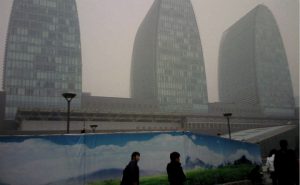The need to address China’s grave environmental issues has led its leaders to declare the need for ‘ecological red lines’ which must be respected, most recently at the Third Plenum in November 2013. Although the term is used frequently by politicians and the media, exactly what constitutes an ecological red line remains unclear.
The term first came to public attention in March 2007, when Wen Jiabao (then Premier) said at a meeting of the National People’s Congress that “the ‘red line’ of retaining 1.8 billion mu of farmland will be stuck to, and the strictest of land management systems implemented.”
The present lack of clarity about the concept has not prevented a number of government departments from issuing their own ‘red lines’, such as the State Forestry Administration, the Ministry of Water Resources, and the Ministry of Environmental Protection (MEP).
When asked by chinadialogue if the MEP’s red line was the same as Xi Jinping’s, Zou Changxin, deputy head of the Ministry of Environmental Protection’s Nanjing Institute of Environmental Sciences said “not entirely. We’re about to put forward a guide called the ecological function baseline, that’s a more narrowly defined ‘red line.”
Zou also shed some light on the differences between these different red lines. He explained that red lines can be either quantitative or qualitative.
“The farmland red line is quantitative – you could build on reserved farmland, if the loss is made up elsewhere. You could use land at location A if you compensate for that loss at location B.
“But if a red line is for the protection of an endangered species and you make that species extinct, you couldn’t make that loss up. The Ministry of Water Resources’ red line for control of water sources covers the amount of water extracted and used, and the efficiency of use. The forestry authorities’ red line covers forestry extent, coverage and volume. The MEP’s red lines and those other red lines are different, in that the MEP’s don’t allow the nature of protection to change, for environmental functions to be lessened, or for area to be reduced.”
Problems in implementation
But defining red lines is of little value unless they are actually implemented. The MEP has been cautious in its estimate of when this will be possible on a national level. Gao Jiexi, head of the MEP’s ecological red line expert group, told the media that “In 2014 the MEP will set red lines at the provincial level, which is relatively easy. But it may take more time to move down to the city and county level.”
Zou said that clear definitions are needed if red lines are to be enforced – there needs to be boundary markers so everyone knows a line is not to be crossed.
He added that there are many other challenges to be faced. Red lines must match up with regional ecological and land use plans. In some trials the MEP found that land it viewed as requiring protection had been earmarked and approved for development, perhaps as an industrial zone or port, in legislative land use plans.
The red lines will ultimately by enforced by local governments and they must bear overall responsibility – so local governments must be on board. Also, different government authorities have their own red lines, and these may conflict with those of the MEP.
The costs of ambiguity
Until there’s clarity and consistency about red lines, many aspects of China’s environment will be vulnerable, such as its nature reserves. Zou provided 2012 figures showing that China had 363 national nature reserves, covering around 9% of China’s territory. There were a further 2,306 provincial nature reserves, covering another 5%. That means nature reserves alone account for 14% of national territory. There are also national forestry reserves and scenic area reserves.
Huge areas with important ecological functions are also protected, accounting for another 24% of China’s territory. National ecological plans restrict development in another 25 large areas. There are also zones where protection of biodiversity is given priority. Overall China has a huge area of land under one form of reserve or another, some overlapping, but not receiving the protection it should.
Talking about the reason for this, Zou pointed out that many of the reserve boundaries were not drawn scientifically in the first place – they were made larger in the hope of attracting more funding. But this makes them hard to protect with the actual manpower and money available. So national ecological security is not being protected, and the environment continues to worsen.
Whether a new wave of red lines will solve the above problems, rather than become another rush for projects, funding and land, remains to be seen.





